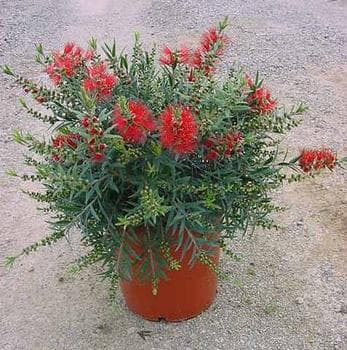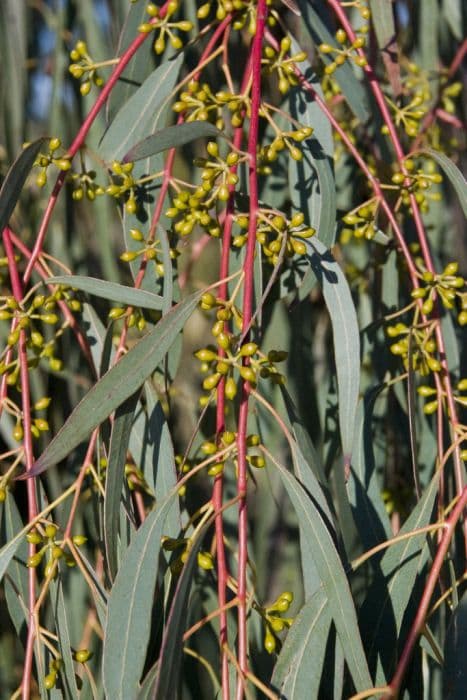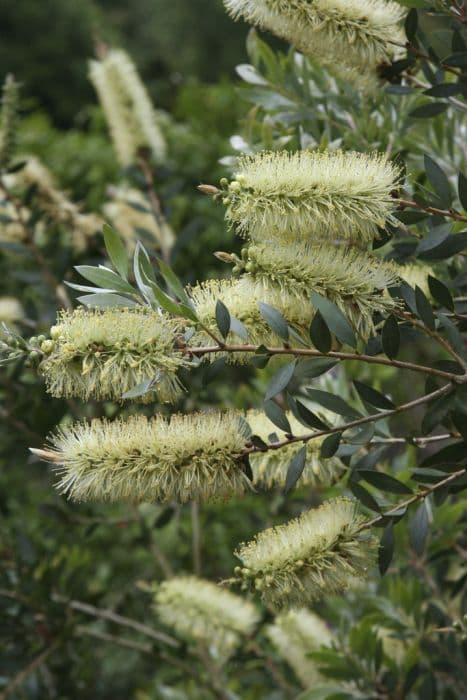Lemon Bottlebrush Callistemon viridiflorus

ABOUT
Callistemon viridiflorus, commonly known as the green bottlebrush, is a striking plant with a unique and vibrant appearance. It is instantly recognized by its distinctive brush-like flowers, which are a bright and unusual green color instead of the more common red or pink hues found in other bottlebrush species. These flowers are spiky, cylindrical in shape, and composed of numerous individual florets, each with prominent and wiry stamens that contribute to the brush-like form. Blossoming typically occurs in spring and summer, attracting a variety of pollinators, like birds and insects. The foliage of the green bottlebrush is also noteworthy, with leaves that are evergreen, narrow, and lance-shaped. They offer a lush backdrop of deep green, sometimes with a slightly grayish tint, and are often aromatic when crushed. The leaves are arranged alternately along the woody stems, creating a full and textured look. Adding to its ornamental appeal, the green bottlebrush possesses a rugged, woody bark that can peel in thin layers, giving the trunk and branches an interesting texture. The overall shape of the plant is open and spreading, with a canopy that provides dappled shade beneath. As an evergreen plant, it retains its foliage throughout the year, making it an enduring element in the landscape. Known for its adaptability to various conditions, the green bottlebrush is a resilient addition to gardens or natural settings where its bright flowers and rich greenery can be appreciated. Despite the absence of mentions about its specific dimensions, it is clear that its size allows it to serve various landscaping purposes, from standalone specimen to part of a hedge or screening plant.
About this plant
 Names
NamesFamily
Myrtaceae
Synonyms
Lemon Bottlebrush, Green Flowering Bottlebrush
Common names
Metrosideros viridiflora, Callistemon sieberi
 Toxicity
ToxicityTo humans
The Lemon Bottlebrush (Callistemon viridiflorus) is not known to be toxic to humans. There is no documented evidence of toxicity leading to symptoms or adverse effects from ingesting parts of this plant. However, as with any plant, individual sensitivities vary, and it's generally advisable not to consume any part of ornamental plants.
To pets
Lemon Bottlebrush (Callistemon viridiflorus) is not commonly reported to be toxic to pets, such as dogs and cats. There are no widely recognized symptoms of poisoning associated with this plant, suggesting it is safe around your furry friends. However, it's always wise to prevent pets from ingesting plants as a precautionary measure.
 Characteristics
CharacteristicsLife cycle
Perennials
Foliage type
Evergreen
Color of leaves
Green
Flower color
Yellow-green
Height
6-10 feet (1.8-3 meters)
Spread
4-6 feet (1.2-1.8 meters)
Plant type
Shrub
Hardiness zones
9
Native area
Australia
Benefits
 General Benefits
General Benefits- Attracts Wildlife: Callistemon viridiflorus, commonly known as green bottlebrush, is known for attracting birds, bees, and butterflies, enhancing biodiversity in the garden.
- Drought Tolerance: Once established, it has good drought tolerance making it suitable for xeriscaping and low-water-use landscapes.
- Ornamental Value: The vibrant green flowers and evergreen foliage provide aesthetic appeal and can be used as a focal point in landscape designs.
- Erosion Control: Its root system helps stabilize soil, thus preventing erosion on slopes and banks.
- Low Maintenance: Green bottlebrush requires minimal care once established, making it ideal for gardeners seeking low-maintenance options.
- Adaptability: It adapts well to a variety of soil types, as long as there is good drainage.
- Windbreak: It can be planted in rows to act as a windbreak, providing shelter from prevailing winds.
- Privacy Screen: When planted in a row, it can create a natural privacy screen for properties.
- Habitat Creation: Provides shelter and nesting sites for local bird species.
- Coastal Resilience: Suitable for coastal areas as it can tolerate sea spray and saline soils.
 Medical Properties
Medical Properties- This plant is not used for medical purposes.
 Air-purifying Qualities
Air-purifying QualitiesThis plant is not specifically known for air purifying qualities.
 Other Uses
Other Uses- Crafting Material: The wood of the bottlebrush can be used in small woodworking projects, such as crafting ornaments or decorative pieces.
- Erosion Control: Due to its robust root system, bottlebrush can be planted to help stabilize soil in areas prone to erosion.
- Tannin Source: The bark of Callistemon viridiflorus can be used as a source of tannins, which are useful in the leather tanning industry.
- Dye Source: The leaves and flowers can be used to produce natural dyes for fabrics or art projects.
- Water Filtering: The plant can be incorporated into water management systems for biofiltration, using its roots to absorb and filter pollutants.
- Culinary Use: The nectar from the flowers can be used as a sweetener or to flavor dishes, although uncommon.
- Insect Repellant: The strong scent of the leaves can be used to repel certain types of insects naturally.
- Habitat for Wildlife: Planting bottlebrush provides habitat and food sources for various birds, insects, and small mammals.
- Privacy Screening: Because of its dense growth, it can be used as a natural privacy screen in gardens and backyards.
- Perfumery: The essential oils extracted from Callistemon viridiflorus can be used in the perfumery industry for their unique scent.
Interesting Facts
 Feng Shui
Feng ShuiThe Bottlebrush is not used in Feng Shui practice.
 Zodiac Sign Compitability
Zodiac Sign CompitabilityThe Bottlebrush is not used in astrology practice.
 Plant Symbolism
Plant Symbolism- Resilience: Callistemon viridiflorus, commonly known as Bottlebrush, often grows in harsh environments, symbolizing the ability to withstand difficult conditions and bounce back.
- Protection: The Bottlebrush has stiff, brush-like flowers that can symbolize guarding or keeping danger at bay.
- Cleansing: With its brush-like appearance, this plant is often associated with a sweeping action or cleansing, representing purity and starting anew.
- Attraction of Positive Energies: The bright, vibrant flowers of the Bottlebrush are believed to attract positivity and good vibes, much as they attract pollinators.
- Healing: The Bottlebrush is also valued for its medicinal properties in some cultures, symbolizing healing and restoration of health.
 Water
WaterThe Lemon Bottlebrush, requires consistent moisture during its growing season, especially when young or newly planted. During the summer, watering once a week with approximately 1 to 1.5 gallons per plant is recommended, depending on the size and the soil conditions. In winter or cooler months, reduce watering to every other week, ensuring the soil is not waterlogged. Always check the top inch of soil for dryness before watering, as overwatering can cause root rot.
 Light
LightFor optimal growth, the Lemon Bottlebrush thrives in full sun, meaning it should receive at least 6 to 8 hours of direct sunlight daily. An ideal spot would be an unobstructed southern or western exposure to ensure the plant receives ample light throughout the day. If grown indoors, place it near a large, sunny window.
 Temperature
TemperatureThe Lemon Bottlebrush prefers warmer climates and does well in temperatures ranging from 50 to 90 degrees Fahrenheit. It can withstand brief periods of colder weather down to about 20 degrees Fahrenheit but should be protected from frost. The ideal temperature range for promoting lush growth and blooms is between 65 and 80 degrees Fahrenheit.
 Pruning
PruningPruning the Lemon Bottlebrush is important to maintain its shape and encourage bushier growth. It is best to prune in late winter or early spring before new growth begins. Remove any dead, damaged, or crossing branches and trim back to shape the plant as desired. Pruning once a year is typically sufficient, but light trimming can be done throughout the year if necessary.
 Cleaning
CleaningAs needed
 Soil
SoilThe best soil mix for the Lemon Bottlebrush should be well-draining, loamy, and slightly acidic to neutral in pH, ranging from 5.5 to 7.0. A mixture containing equal parts of peat, pine bark, and coarse sand or perlite is ideal to ensure proper drainage and aeration. Regular testing and adjustment of the soil's pH level can help maintain the optimal conditions for this plant.
 Repotting
RepottingThe Lemon Bottlebrush should be repotted every 2 to 3 years to prevent it from becoming root-bound and to replenish the soil's nutrients. Younger plants grow more rapidly and may require more frequent repotting, while older, established plants can be repotted less often.
 Humidity & Misting
Humidity & MistingThe Lemon Bottlebrush prefers moderate humidity levels. It thrives in conditions that replicate its natural environment, typically around 40-50% relative humidity. While it can endure variations, maintaining consistent humidity will help ensure the plant's health and flowering capabilities.
 Suitable locations
Suitable locationsIndoor
Place Lemon Bottlebrush near a sunny window and rotate.
Outdoor
Grow in full sun with well-draining soil; shelter from winds.
Hardiness zone
8-11 USDA
 Life cycle
Life cycleCallistemon viridiflorus, commonly known as the Green Flowering Bottlebrush, begins its life cycle through seed germination, which typically occurs after fire or when the seed comes in contact with moist, warm soil. The seedling stage follows, during which the plant develops its first true leaves and a root system that allows it to absorb nutrients and water. As it enters the juvenile stage, the Bottlebrush experiences rapid growth, producing foliage and developing its characteristic shrubby form. The plant reaches maturity in a few years, marked by the onset of flowering, with bright green cylindrical flower spikes attracting pollinators like birds and bees. Following pollination, fruits in the form of woody capsules form, containing seeds that will remain dormant until triggered by environmental conditions such as heat from fire. In its adult stage, the Green Flowering Bottlebrush will continue to flower annually and produce seeds, completing the life cycle and contributing to the regeneration of the species.
 Propogation
PropogationPropogation time
Spring-Early Summer
Propogation: Callistemon viridiflorus, commonly known as lemon bottlebrush, is typically propagated through semi-hardwood cuttings. The optimal time for taking these cuttings is in the late summer or early fall. To propagate, a cutting of about 4 to 6 inches (10 to 15 centimeters) is taken from a healthy, disease-free parent plant. The lower leaves are removed, and the cut end can be dipped into a rooting hormone to encourage root development. The cutting is then planted in a moist, well-draining soil mix, ensuring that the nodes where the leaves were removed are buried in the soil as this is where roots will develop. The container with the cutting should be kept in a warm, sheltered position with indirect light until roots have established, after which the new plant can be gradually acclimatized to direct sunlight and eventually transplanted outdoors.









